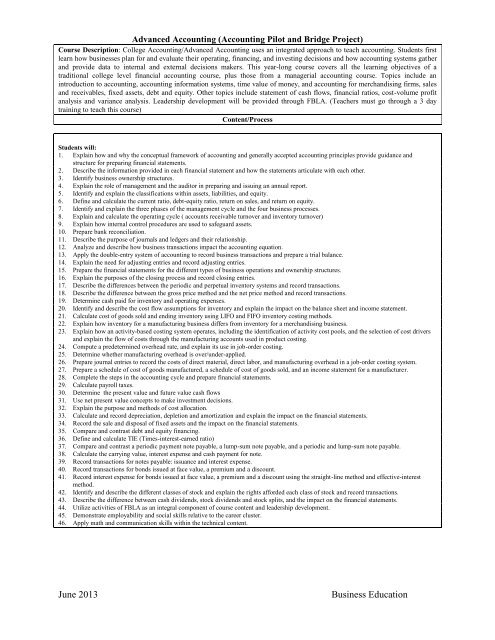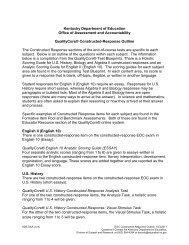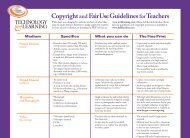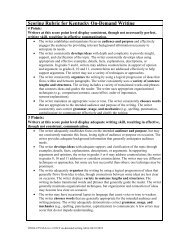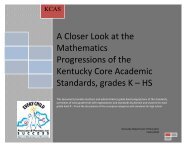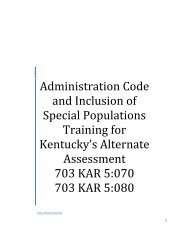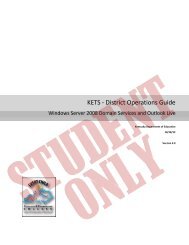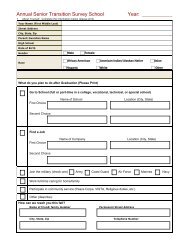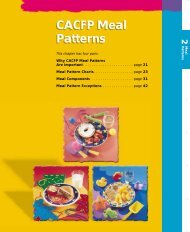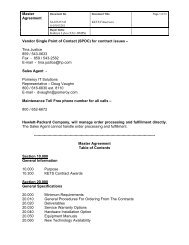Business Education Program of Studies - Kentucky Department of ...
Business Education Program of Studies - Kentucky Department of ...
Business Education Program of Studies - Kentucky Department of ...
You also want an ePaper? Increase the reach of your titles
YUMPU automatically turns print PDFs into web optimized ePapers that Google loves.
Advanced Accounting (Accounting Pilot and Bridge Project)Course Description: College Accounting/Advanced Accounting uses an integrated approach to teach accounting. Students firstlearn how businesses plan for and evaluate their operating, financing, and investing decisions and how accounting systems gatherand provide data to internal and external decisions makers. This year-long course covers all the learning objectives <strong>of</strong> atraditional college level financial accounting course, plus those from a managerial accounting course. Topics include anintroduction to accounting, accounting information systems, time value <strong>of</strong> money, and accounting for merchandising firms, salesand receivables, fixed assets, debt and equity. Other topics include statement <strong>of</strong> cash flows, financial ratios, cost-volume pr<strong>of</strong>itanalysis and variance analysis. Leadership development will be provided through FBLA. (Teachers must go through a 3 daytraining to teach this course)Content/ProcessStudents will:1. Explain how and why the conceptual framework <strong>of</strong> accounting and generally accepted accounting principles provide guidance andstructure for preparing financial statements.2. Describe the information provided in each financial statement and how the statements articulate with each other.3. Identify business ownership structures.4. Explain the role <strong>of</strong> management and the auditor in preparing and issuing an annual report.5. Identify and explain the classifications within assets, liabilities, and equity.6. Define and calculate the current ratio, debt-equity ratio, return on sales, and return on equity.7. Identify and explain the three phases <strong>of</strong> the management cycle and the four business processes.8. Explain and calculate the operating cycle ( accounts receivable turnover and inventory turnover)9. Explain how internal control procedures are used to safeguard assets.10. Prepare bank reconciliation.11. Describe the purpose <strong>of</strong> journals and ledgers and their relationship.12. Analyze and describe how business transactions impact the accounting equation.13. Apply the double-entry system <strong>of</strong> accounting to record business transactions and prepare a trial balance.14. Explain the need for adjusting entries and record adjusting entries.15. Prepare the financial statements for the different types <strong>of</strong> business operations and ownership structures.16. Explain the purposes <strong>of</strong> the closing process and record closing entries.17. Describe the differences between the periodic and perpetual inventory systems and record transactions.18. Describe the difference between the gross price method and the net price method and record transactions.19. Determine cash paid for inventory and operating expenses.20. Identify and describe the cost flow assumptions for inventory and explain the impact on the balance sheet and income statement.21. Calculate cost <strong>of</strong> goods sold and ending inventory using LIFO and FIFO inventory costing methods.22. Explain how inventory for a manufacturing business differs from inventory for a merchandising business.23. Explain how an activity-based costing system operates, including the identification <strong>of</strong> activity cost pools, and the selection <strong>of</strong> cost driversand explain the flow <strong>of</strong> costs through the manufacturing accounts used in product costing.24. Compute a predetermined overhead rate, and explain its use in job-order costing.25. Determine whether manufacturing overhead is over/under-applied.26. Prepare journal entries to record the costs <strong>of</strong> direct material, direct labor, and manufacturing overhead in a job-order costing system.27. Prepare a schedule <strong>of</strong> cost <strong>of</strong> goods manufactured, a schedule <strong>of</strong> cost <strong>of</strong> goods sold, and an income statement for a manufacturer.28. Complete the steps in the accounting cycle and prepare financial statements.29. Calculate payroll taxes.30. Determine the present value and future value cash flows31. Use net present value concepts to make investment decisions.32. Explain the purpose and methods <strong>of</strong> cost allocation.33. Calculate and record depreciation, depletion and amortization and explain the impact on the financial statements.34. Record the sale and disposal <strong>of</strong> fixed assets and the impact on the financial statements.35. Compare and contrast debt and equity financing.36. Define and calculate TIE (Times-interest-earned ratio)37. Compare and contrast a periodic payment note payable, a lump-sum note payable, and a periodic and lump-sum note payable.38. Calculate the carrying value, interest expense and cash payment for note.39. Record transactions for notes payable: issuance and interest expense.40. Record transactions for bonds issued at face value, a premium and a discount.41. Record interest expense for bonds issued at face value, a premium and a discount using the straight-line method and effective-interestmethod.42. Identify and describe the different classes <strong>of</strong> stock and explain the rights afforded each class <strong>of</strong> stock and record transactions.43. Describe the difference between cash dividends, stock dividends and stock splits, and the impact on the financial statements.44. Utilize activities <strong>of</strong> FBLA as an integral component <strong>of</strong> course content and leadership development.45. Demonstrate employability and social skills relative to the career cluster.46. Apply math and communication skills within the technical content.June 2013<strong>Business</strong> <strong>Education</strong>


